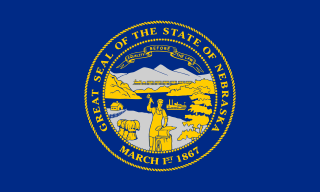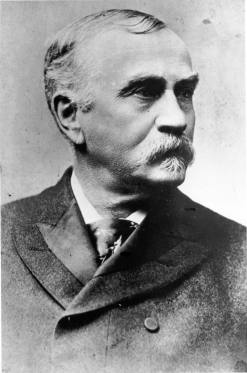
Nebraska is a triply landlocked state in the Midwestern region of the United States. It borders South Dakota to the north; Iowa to the east and Missouri to the southeast, both across the Missouri River; Kansas to the south; Colorado to the southwest; and Wyoming to the west. Nebraska is the 16th largest state by land area, with just over 77,220 square miles (200,000 km2). With a population of over 1.9 million, it is the 38th most populous state and the 7th least densely populated. Its capital is Lincoln, and its most populous city is Omaha, which is on the Missouri River. Nebraska was admitted into the United States in 1867, two years after the end of the American Civil War. The Nebraska Legislature is unlike any other American legislature in that it is unicameral, and its members are elected without any official reference to political party affiliation. Nebraska is one of only two states that divide electoral college votes by district, and is not winner-take-all.
The New York Times Best Seller list is widely considered the preeminent list of best-selling books in the United States. The New York Times Book Review has published the list weekly since October 12, 1931. In the 21st century, it has evolved into multiple lists, grouped by genre and format, including fiction and nonfiction, hardcover, paperback and electronic.

Rose Cecil O'Neill was an American cartoonist, illustrator, artist, and writer. She rose to fame for her creation of the popular comic strip characters, Kewpies, in 1909, and was also the first published female cartoonist in the United States.

Julius Sterling Morton was a Nebraska newspaper editor and politician who served as President Grover Cleveland's secretary of agriculture. He was a prominent Bourbon Democrat, taking a conservative position on political, economic, and social issues, and opposing agrarianism. Among his most notable achievements was the founding of Arbor Day in 1872. In 1897 he started a weekly magazine entitled The Conservative.

NFM is a home furnishing store in North America that sells furniture, flooring, appliances and electronics. It is the largest of its kind in North America. NFM was founded in 1937 by Belarus-born Rose Blumkin, who was known as Mrs. B., in Omaha, Nebraska, United States. Under the motto "sell cheap and tell the truth," she worked in the business until age 103. In 1983, Mrs. B. sold a majority interest to Berkshire Hathaway on a handshake deal with Warren Buffett for $60 million.
The history of slavery in Nebraska is generally seen as short and limited. The issue was contentious for the legislature between the creation of the Nebraska Territory in 1854 and the outbreak of the American Civil War in 1861.

Jay Holcomb Neff was a newspaper publisher and Mayor of Kansas City, Missouri from 1904 to 1906.

The history of the U.S. state of Nebraska dates back to its formation as a territory by the Kansas–Nebraska Act, passed by the United States Congress on May 30, 1854. The Nebraska Territory was settled extensively under the Homestead Act of 1862 during the 1860s, and in 1867 was admitted to the Union as the 37th U.S. state. The Plains Indians are the descendants of a long line of succeeding cultures of indigenous peoples in Nebraska who occupied the area for thousands of years before European arrival and continue to do so today.
The 1891 Iowa Hawkeyes football team represented the University of Iowa during the 1891 college football season. It ended in controversy. Following victories over Cornell College and Nebraska, and losses to Minnesota and Iowa College, the Hawkeyes were 2–2 heading into their final game against Kansas in Kansas City, Missouri. Following an argument where Kansas argued that Iowa had not put the ball into play fairly, the Jayhawks left the field claiming a 14–12 victory. However, the game was not called until after the next play, when Iowa scored an uncontested touchdown. Today, Iowa lists the game as an 18–14 Hawkeye victory.
The Fred Krug Brewery was located at 2435 Deer Park Boulevard in Omaha, Nebraska. Founded in 1859, Krug Brewery was the first brewery in the city. Krug was one of the "Big 4" brewers located in Omaha, which also included the Storz, Willow Springs and Metz breweries. Later sold to Falstaff in 1936, the facility closed in 1987.

Alfred D. Jones was a late 19th-century lawyer, surveyor and politician in the Midwestern United States. In 1846 he platted Fort Des Moines, Iowa, and in 1854 he platted Omaha, Nebraska. He became the first settler in Omaha, as well as the first postmaster, a member of the first Omaha City Council and the first Omaha School Board, and was among the first legislators of the Nebraska Territory.

Native American tribes in the U.S. state of Nebraska have been Plains Indians, descendants of succeeding cultures of indigenous peoples who have occupied the area for thousands of years. More than 15 historic tribes have been identified as having lived in, hunted in, or otherwise occupied territory within the current state boundaries.

The Illinois Central Missouri River Bridge, also known as the IC Bridge or the East Omaha Bridge, is a rail through truss double swing bridge across the Missouri River connecting Council Bluffs, Iowa, with Omaha, Nebraska. It is owned by the Canadian National Railway and is closed to all traffic. At 521 feet long, the second version of the bridge was the longest swing bridge in the world from when it was completed in 1903 through 1915. In 1975 it was regarded as the third longest swing bridge.
Significant events in the history of Omaha, Nebraska, include social, political, cultural, and economic activities.

The 2011 flooding event on the Missouri River in the United States was triggered by record snowfall in Rocky Mountains of Montana and Wyoming along with near-record spring rainfall in central and eastern Montana. All six major dams along the Missouri River released record amounts of water to prevent overflow which led to flooding threatening several towns and cities along the river from Montana to Missouri; in particular Bismarck, North Dakota; Pierre, South Dakota; Dakota Dunes, South Dakota; South Sioux City, Nebraska, Sioux City, Iowa; Omaha, Nebraska; Council Bluffs, Iowa; Saint Joseph, Missouri; Kansas City, Missouri; Jefferson City, Missouri, and St. Louis, Missouri. Many smaller towns were also at risk, suffering the same fate as the larger cities if not worse. According to the National Weather Service, in the second half of the month of May 2011, almost a year's worth of rain fell over the upper Missouri River basin. Extremely heavy rainfall in conjunction with an estimated 212 percent of normal snowpack in the Rocky Mountains contributed to this flooding event.

For the 1921 film adaptation see The Jucklins (film)

Josephine Silone Yates was an American professor, writer, public speaker, and activist. She trained in chemistry and became one of the first black professors hired at Lincoln University in Jefferson City, Missouri. Upon her promotion, she became the first black woman to head a college science department. She may have been the first black woman to hold a full professorship at any U.S. college or university.
Thomas P. Mahammitt was a journalist, caterer, civil rights activist, and civic leader from Omaha Nebraska. He was owner and editor for the black weekly, The Enterprise, Omaha's leading black paper at the turn of the 20th century. He was also an active leader in the Masons and the Boy Scouts and was named "Omaha's most distinguished Negro citizen" in 1934.

Ella Lillian Davis Browne Mahammitt was an American journalist, civil rights activist, and women's rights activist from Omaha, Nebraska. She was editor of the black weekly newspaper The Enterprise, president of Omaha's Colored Women's Club, and an officer of local branches of the Afro-American League. In 1895, she was vice-president of the National Federation of Afro-American Women, headed by Margaret James Murray, and in 1896 was a committee member of the successor organization, the National Association of Colored Women, under president Mary Church Terrell.













